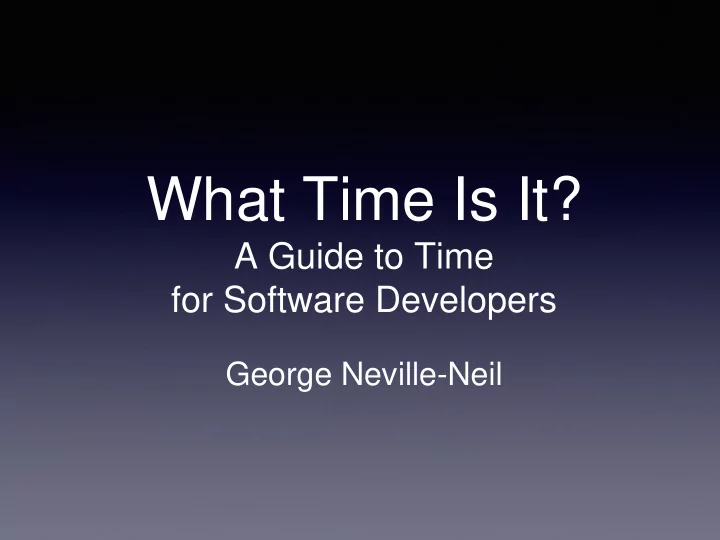

What Time Is It? A Guide to Time for Software Developers George Neville-Neil
ACM Highlights • Learning Center tools for professional development: http: / / learning.acm.org 1,400+ trusted technical books and videos by O ’ Reilly, Morgan Kaufm ann , etc. • • Online training toward top vendor certifications (CEH, Cisco, CISSP, CompTIA, PMI, etc.) • Learning Webinars from thought leaders and top practitioner • ACM Tech Packs (annotated bibliographies compiled by subject experts • Podcast interviews with innovators and award winners • Popular publications: • Flagship Communications of the ACM ( CACM) magazine: http: / / cacm.acm.org/ • ACM Queue magazine for practitioners: http: / / queue.acm.org/ • ACM Digital Library , the world’s most comprehensive database of computing literature: http: / / dl.acm.org. • International conferences that draw leading experts on a broad spectrum of computing topics: http: / / www.acm.org/ conferences. • Prestigious awards, including the ACM A.M. Turing and Infosys: http: / / awards.acm.org/ • And much more… http: / / www.acm .org.
What Time Is It? A Guide to Time for Software Developers George Neville-Neil
Time is an Illusion • Created by people for people • Provides ordering to the day • Necessary for basic, human, communication
A Brief History of… • Seasons • Months • Days • Hours • Minutes • Seconds
Finer grains • 1 second • 1,000 milliseconds • 1,000,000 microseconds • 1,000,000,000 nanoseconds
How do I use time? • In my programs? • In deployed systems? • Time is pervasive • Most systems are distributed systems
Programming with Time • Takes time to get time • gettimeofday(2) • Traditional • clock_gettime(2) • Finer grained controls
What's wrong with computer time? • Cheap Crystals • Systems run hot and cold • Age of crystals • Workload effects • Harder than you (or your management) might think
Technology always makes things better
Can you see it?
How bad is it? • Offset starts at 0,0 • 23:00-01:00 (2 hours) • 15ms behind • Typical behavior
Who cares about a little wander? • Debugging distributed systems • Reconciling on-line transactions • Robots and Automation • Power Grids • Cellular Networks
When is a second not a second? • Syntonization is not synchronization • Frequency inputs to massage the clock • Pulse Per Second (1PPS) • Other frequencies available, at a cost
What is your tolerance? • Financial Transactions • FINRA: 1 second (for now) • Robot Arm • Powerline • 1/50th or 1/60th of a second • Cellular Networks
Solutions? • Better crystals • Not on commodity hardware • Add on cards • Expensive for large deployments • Ask a better clock • Current state of the art
Ask a better clock • A clock with a better crystal exists • Clients synchronize to the better clock • Complications
Basic Theory of Operation • Stratum • Time Transfer • Ask, “What time is it?” • Measure and correct for network propagation time • Steer the local clock
Network Time Protocol (NTP) • V3 RFC 1305 (1992) • V4 RFC 5905 (2010) • Internet Based Timekeeping • Client/server model • Default polling is once per 64 seconds • Can take hours to synchronize
Some Definitions • Synchronization • My neighbor and I know it is 3pm • Syntonization • The duration of a second is one second • Network Jitter • Variance in network latency • Grand Master • The better clock
Time in the Cloud
What?! • Default NTP config • Polling 50 times per day • +/- 5ms
Precision Time Protocol (PTP) • IEEE-1588 v1 (2002) v2 (2008) v3 (???) • LAN Environment • Multicast • Better than 1usec accuracy with software only • Hardware Support Available
PTP
How did you do that? • Graph includes 24 hours • Hundreds of measurements per hour • Median 300ns • +/- 30usec around 0 • Client is pure software • Master is a Meinberg M600
PTP in Packets DELAY RESPONSE GM DELAY REQUEST Slave Slave Slave Slave SYNC FOLLOWUP
Sources of jitter • Routers • Switches • Links • Electronic Noise • Software
Where does the time go? • NIC Interrupts • Packet Buffering • OS Scheduling • Software Stack
Where does the time go?
For my next trick… • Every packet has a sequence number • All packets are multicast • All hosts see the packets “at the same time” Alas…16 bit sequence number
Inter Host Quality • For each SYNC record the system time • Post process files • Show the offset between hosts • Included in PTPd (Quality File)
PTPd • BSD Licensed • Supports IEEE-1588v2 • Interoperates with NTPd • http://ptpd.sf.net
The Leap Second • Adjustment based on astronomical measurement • Periodically adds a second to the clock • 23:59:60 • Can occur at the end of any month • But usually June or December
ACM: The Learning Continues… • Questions about this webcast? learning@acm.org • ACM Learning Webinars (on-demand archive): http://learning.acm.org/webinar • ACM Learning Center: http://learning.acm.org • ACM Queue: http://queue.acm.org/
Recommend
More recommend